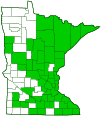Japanese barberry
(Berberis thunbergii)
Conservation • Weed • Wetland • Description • Habitat • Ecology • Use • Distribution • Taxonomy
Description |
||
Japanese barberry is an exotic, invasive, thorny shrub. It is native to Japan and has been cultivated around the world as an ornamental. It occasionally escapes cultivation and is now widely naturalized in Europe, China, and North America. It was introduced into North America in the 1800s. In the United States it is now common from Maine to Minnesota south to North Carolina and Missouri, with scattered populations in the west. In Minnesota it is common in the eastern half of the state with scattered populations in the western half. It is found in open, bottomland and upland woodlands; woodland edges and openings; pastures and meadows; yards; old fields, roadsides, and other disturbed places. It grows in well-drained, moist to dry soil under full sun to medium shade. It is a restricted noxious weed in Minnesota. The state recognizes – and prohibits – 25 cultivars in addition to the parent species. Japanese barberry is a deciduous, woody, perennial shrub. It rises on multiple stems from a shallow root system that consists of underground, horizontal stems (rhizomes), a root crown, and many fine roots. It can be 1′ to 10′ in height, though in Minnesota it is rarely more than 6′ tall and usually no more than 3′ tall. It sometimes forms large, impenetrable thickets. The shrubs are dense, compact, and mostly wider than tall. Two kinds of stems are produced, long stems and spur stems. Long, spiny, densely branched stems rise from the root crown. These stems are erect near the center of the shrub to lying on the ground with just the tips curved upward (decumbent). Additional young stems (shoots) rise at intervals along the rhizomes. Second-year stems are purple or brown, hairless, angular, and ridged. Older stems are striped in shades of brown. On large shrubs the oldest stems have rough, gray bark. Most of the leaves on long stems are replaced by single spines. The spines are stiff, about ½″ long, and usually unbranched, sometimes 3-branched. Short, leafy, spur stems are produced in the upper angle (axil) where each thorn attaches to the long stem. Two to six leaves are clustered at the end of each spur stem. The leaves are alternately arranged but very closely spaced on the stem and usually do not appear alternate. They are widest toward the end, inversely egg-shaped or spatula-shaped, ½″ to 15 ⁄16″ (12 to 24 mm) long, and ⅛″ to ⅜″ (3 to 10 mm) wide. They may be stalkless or on 1 ⁄32″ to 5 ⁄16″ (1 to 8 mm) long leaf stalks. The leaf blade is thin, flexible, unlobed, long-tapered at the base, and rounded or broadly angled at the tip. The upper and lower surfaces are green, dull, and hairless. The margins are flat and untoothed. The inflorescence is usually an umbrella-like cluster (umbel) of 2 to 5 flowers, sometimes just a single flower, at the end of each spur stem. The umbels are ⅜″ to ⅝″ (10 to 15 mm) long and are produced along the entire length of the long stem. Each flower droops at the end of a short stalk. At the base of each flower there are 3 small modified floral leaves (bracteoles). The bracteoles are membranous and narrowly angled at the tip. There are 6 outer floral leaves (sepals), 6 petals, 6 stamens, and 1 style. The sepals are petal-like, yellow, curved inward, widely spreading, and ⅛″ to 3 ⁄16″ (3 to 5 mm) long. The sepals and bracteoles are shed immediately after the flower fully opens. The petals are yellow and ⅛″ (2.3 to 3.0 mm) long. They are erect and curved inward, forming a protective cup around the reproductive parts of the flower. The fruit is a bright red, juicy, globe-shaped or elliptical, ⅜″ (9 to 10 mm) long berry with 1 to 10 seeds. The berries remain on the plant throughout the winter. |
||
Height |
||
1′ to 10′ |
||
Flower Color |
||
Yellow |
||
Similar Species |
||
Habitat |
||
Moist to dry. Open, bottomland and upland woodlands; woodland edges and openings; pastures and meadows; yards; old fields, roadsides, and other disturbed places. Full sun to medium shade. |
||
Ecology |
||
Flowering |
||
May through early June |
||
Pests and Diseases |
||
|
||
Use |
||
|
||
Distribution |
||||
|
Sources |
|||
| 3/18/2023 | ||||
Nativity |
||||
Native to Japan. Introduced, escaped cultivation, and and widely naturalized. |
||||
Occurrence |
||||
Common |
||||
Taxonomy |
|||
| Kingdom | Plantae (Plants) | ||
| Division | Tracheophyta (Vascular Plants) | ||
| Subdivision | Spermatophytina (Seed Plants) | ||
| Class | Magnoliopsida (Dicots) | ||
| Superorder | Ranunculanae | ||
Order |
Ranunculales (Buttercups, Poppies, and Allies) | ||
Family |
Berberidaceae (barberry) | ||
| Subfamily | Berberidoideae | ||
| Tribe | Berberideae | ||
| Subtribe | Berberidinae | ||
Genus |
Berberis (barberries) | ||
Subordinate Taxa |
|||
|
|||
Synonyms |
|||
Berberis thunbergii var. atropurpurea |
|||
Common Names |
|||
barberry holly grape Japanese barberry Japanese berberis Oregon-grape Thunberg's barberry |
|||
Glossary
Axil
The upper angle where a branch, stem, leaf stalk, or vein diverges.
Bracteole
A small, often secondary bract within an inflorescence; a bract that is borne on a petiole instead of subtending it; bractlet.
Rhizome
A horizontal, usually underground stem. It serves as a reproductive structure, producing roots below and shoots above at the nodes.
Sepal
An outer floral leaf, usually green but sometimes colored, at the base of a flower.
Spreading
Extending nearly horizontal.
Umbel
A flat-topped or convex, umbrella-shaped cluster of flowers or buds arising from more or less a single point.
Visitor Photos |
|||||
Share your photo of this plant. |
|||||
| This button not working for you? Simply email us at info@MinnesotaSeasons.com. Attach one or more photos and, if you like, a caption. |
|||||
|
|||||
MinnesotaSeasons.com Photos |
|||||
Plant |
|||||
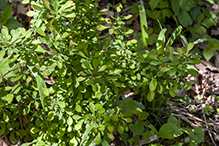 |
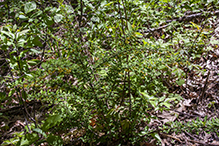 |
||||
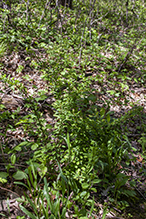 |
|||||
Stem |
|||||
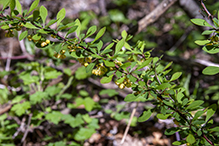 |
|||||
Inflorescence |
|||||
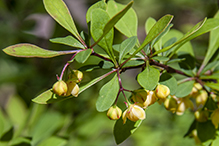 |
|||||
Flowers |
|||||
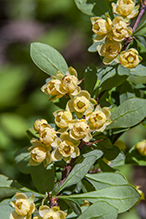 |
|||||
Leaves |
|||||
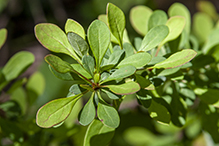 |
|||||
Cultivar |
|||||
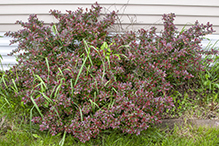 |
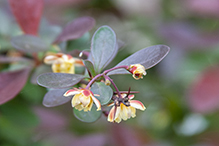 |
||||
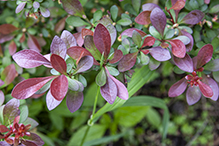 |
|||||

Slideshows |
||
| Berberis thunbergii - Japanese Barberry Virens (Latin for greening) |
||
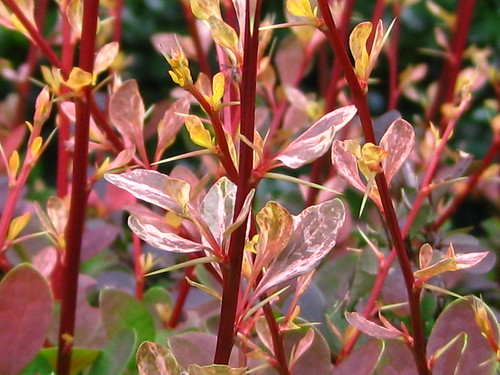
|
||
About
Berberidaceae - Barberry Family An invasive species which which poses an ecological threat to natural areas of the Lower Hudson Valley of New York State. Source: |
||

Visitor Videos |
|||
Share your video of this plant. |
|||
| This button not working for you? Simply email us at info@MinnesotaSeasons.com. Attach a video, a YouTube link, or a cloud storage link. |
|||
Other Videos |
|||
| ⟹ BARBERRY | Berberis thunbergii | A very thorny plant an really hard to remove! here's why! ☼ Heirloom reviews ☼ |
|||
About
Jun 5, 2017 Here's the BARBERRY, Berberis thunbergii! The plant is in the Berberidaceae family. It is a poisonous plant so don't eat any part of it except for maybe the berries an parts of the roots. If you come into contact with it, be careful of the thorns. Tho this plant may NOT be an invasive specie it can become a major problem if you let it go! The plant is both poisonous and used in folk medicine. Tune in to find out why! : ) Never eat a plant you can't fully identify!! So if you like this video don't forget to LIKE, SHARE, SUBSCRIBE! #heirloomreview #barberry #plant #bush #invasive NOTE: I know i said its an invasive species but NOT all species are in the USA. but can be invasive in nature. |
|||
| How to identify Japanese barberry (Berberis thunbergii) Tree Learning |
|||
About
Aug 6, 2019 Learn how to identify the invasive plant, Japanese barberry (Berberis thunbergii).. How do you manage this species at your site? Please post your response in the "comments" section below! |
|||

Visitor Sightings |
|||||
Report a sighting of this plant. |
|||||
| This button not working for you? Simply email us at info@MinnesotaSeasons.com. Be sure to include a location. |
|||||
|
|||||
MinnesotaSeasons.com Sightings |
|||||

Created: 1/1/2020
Last Updated:
